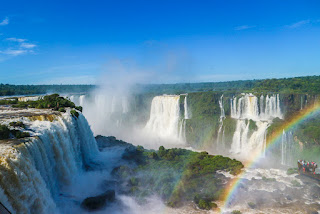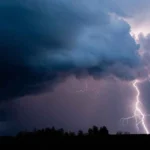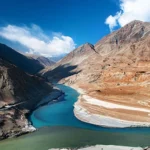
The Iguazu Falls are a pair of waterfalls on the border of Argentina and Brazil that divide the Iguazu River into upper and lower levels. The Spanish explorer lvar Nez Cabeza de Vaca was the first European to see Iguazu Falls in 1541. The Iguazu waterfall system encompasses 1.7 miles of the Iguzu River and includes 275 waterfalls. The name Iguazu is derived from two words that mean “water” and “large.” These words do not do justice to the magnificence of this natural marvel. In 2011, Iguazu Falls was named one of the New Seven Wonders of Nature.
There is a legend that describes how the falls came to be. A god was to marry Naipi, a lovely woman.
The god was enraged when this woman canoed away with her lover. The god became enraged and slashed the river, creating not only the falls but also condemning the two lovers to fall for eternity.
The falls are 1.7 miles long and are separated by islands along the edge. These falls range in height from 197 to 269 feet. Most of the falls are 210 feet tall on average.
The actual number of waterfalls varies depending on the water level and the amount of water flowing. At any given time, the number falls between 150 and 300.
The Iguazu River is accessible from three cities in three countries: Brazil, Argentina, and Paraguay.
Water does not flow over 2,950 feet along the 1.7 mile section of the river that forms Iguazu Falls.
In 1541, the first European to see the falls was the Spanish explorer lvar Nez Cabeza de Vaca. On the Argentina side, one of the falls is named after him.
Argentina owns two-thirds of the Iguazu Falls.
Iguazu Falls has the highest annual average flow of any waterfall in the world, exceeding Niagara Falls.
Iguazu Falls is twice as tall as Niagara Falls and twice as wide.
The Iguazu Falls were formed by a volcanic eruption. A large crack was formed as a result of this eruption.
The water levels are at their lowest in the winter, and it is extremely humid and hot in the summer, so the best times to visit are in the spring and fall.
The rainy season lasts from November to March. Iguazu Falls can have a flow rate of up to 450,000 cubic feet per second at times.
The Devil’s Throat is the most impressive of the Iguazu Falls. It’s a U-shaped chasm with 14 falls that drop more than 350 feet.
The mist that rises from Devil’s Throat Falls can reach 490 feet at times.
Great Dusky Swifts are a type of bird that frequently nests behind the falls. They can even be seen diving right into the falls.
The rain forests surrounding Iguazu Falls are home to over 2000 plant species.
Eleanor Roosevelt, the wife of former President Franklin D. Roosevelt, paid a visit to the falls. When she first saw Iguazu Falls, she exclaimed, “Poor Niagara!”
Iguazu Falls has appeared in a number of films, including Indiana Jones and the Kingdom of the Crystal Skull, Miami Vice, Mr. Magoo, and others.
On November 11, 2011, Iguazu Falls was named one of the New 7 Wonders of Nature. It is also designated as a UNESCO World Heritage Site.
Frequently Asked Questions about Iguazu Falls
Iguazu Falls, also spelled Iguaçu Falls, is a majestic cascade system on the border between Argentina and Brazil. Here are some of the most common questions people search about this natural wonder:
How big are Iguazu Falls?
Iguazu Falls is not one single waterfall, but rather a collection of 275 separate falls spread over nearly 3 kilometers (2 miles) along the Iguazu River. The height of the falls varies, with the Devil’s Throat (Garganta del Diablo in Spanish) being the most impressive, plunging 80 meters (269 feet) into a churning pool below.
What’s the best time to visit Iguazu Falls?
Iguazu Falls is a year-round destination, but the ideal time depends on your preferences:
- Water Volume: For the most dramatic display of water cascading down the falls, visit during the wet season (December to February). However, expect higher water levels to potentially obscure some viewpoints and create more spray.
- Weather: The dry season (June to July) offers pleasant temperatures and less rain, making for comfortable exploration of the trails. However, the falls may be less voluminous during this time.
- Crowds: Avoid peak tourist seasons like local holidays, February, and Easter if you prefer a less crowded experience.
What side is better to see Iguazu Falls, Argentina or Brazil?
Both the Argentinian and Brazilian sides offer unique perspectives of the falls:
-
Argentina: This side provides panoramic views of the vast Iguazu River Canyon and most of the falls, including Devil’s Throat. It has a well-developed network of trails, allowing visitors to get up close to the cascading water.
-
Brazil: This side offers stunning direct views of Devil’s Throat, considered the most powerful section of the falls. The trails here are shorter and more accessible, making it a good option for visitors with limited mobility.
Ideally, visiting both sides allows for a comprehensive experience of Iguazu Falls.
How much does it cost to visit Iguazu Falls?
Entrance fees vary depending on the season and the side you visit (Argentina or Brazil). Typically, tickets include access to walking trails, visitor centers, and transportation within the park. Additional costs may include:
- National Park entrance fees (separate for Argentina and Brazil)
- Guided tours
- Boat rides under the falls (offered on the Argentinian side)
- Transportation to the falls from nearby towns (Puerto Iguazu in Argentina or Foz do Iguaçu in Brazil)
What should I pack for a trip to Iguazu Falls?
Here are some essentials for your Iguazu Falls adventure:
- Comfortable walking shoes with good grip (trails can be slippery)
- Rain gear (especially during the wet season)
- Quick-drying clothing
- Hat and sunglasses
- Sunscreen and insect repellent
- Reusable water bottle
- Camera (waterproof case recommended)
- Local currency (cash may be needed for some purchases)
- Passport and visa (if required for your nationality)
Is it safe to visit Iguazu Falls?
Iguazu Falls is generally a safe destination. However, it’s important to be aware of your surroundings and follow safety guidelines:
- Stay on designated trails and walkways.
- Be cautious around slippery rocks and uneven surfaces.
- Be mindful of wildlife encounters, especially coatis (small, curious mammals). Don’t feed them.
- Follow park regulations regarding belongings and photography near the falls.
What else is there to do near Iguazu Falls?
The surrounding areas on both the Argentinian and Brazilian sides offer various activities beyond the falls:
- Argentina: Explore the Iguazú National Park with its diverse rainforest ecosystem, go bird watching, or visit the nearby Itaipu Dam, one of the world’s largest hydroelectric dams.
- Brazil: Visit the Itaipu Dam, experience the vibrant nightlife of Foz do Iguaçu, or go bird watching in Iguaçu National Park.
These are just a few of the many questions people have about Iguazu Falls. With its awe-inspiring beauty and diverse experiences, Iguazu Falls is a natural wonder worth exploring.









